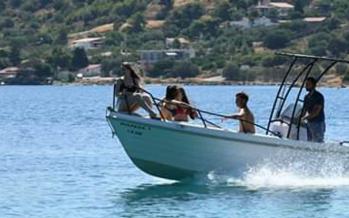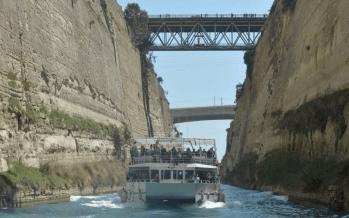Coastal and marine tourism includes those recreational activities which involve travel away from one's place of residence which have as their host or focus the marine environment and/or the coastal zone. Loutraki and most of the municipality are located on the coastal zone, being a seaside resort so the marine exploration and activities is a part of the discovery every visitor will experience.
The Dreamland of beaches
The busy cosmopolitan “Blue Flag” awarded beach of Loutraki with its endless lacy coastline, is always full of life and people. Cafes, beach-bars and restaurants spread all along the seaside area. Indulge in the summer spirit and enjoy your refreshing drink or coffee in a sunbed by the sea. Another “Blue Flag” awarded beach, Pefkakia, is one of the most popular beaches in the Agioi Theodoroi area. It’s a piny, coastal zone all along the entrance of the city that offers a totally awesome view to the Saronic Gulf.
The beach experience goes much further in the Municipality of Loutraki, Perachora, Agioi Theodoroi. Heraion Lagoon, Flabouro, Krifi and the virgin northern beaches, Mylokopi, Skalosia, Strava are only a few of the hidden paradises open for exploration. The uniqueness of each one of the beaches and the unparalleled beauty of their scenery have famed this place as the dreamland of beaches.
Corinthian Gulf Dolphins
Dolphins are by far the most loving and fascinating sea creatures. There are the symbol and friendship and solidarity and are adored by children and adults equally. Loutraki has a special bond with those amazing creatures as they are long time companions of our town, occupying our seas since antiquity. A true and loyal friend, we propose that you dedicate your time to cruise the northern part of the Corinthian Gulf and meet our lovely “buddies”!
Until then, read their full story by WWF Greece.
The life of the Stripped Dolphins !
Source: http://www.wwf.gr/en/endangered-species/marine-mammals/dolphin
Did you know that the smallest dolphin species in the world lives in the Corinthian Gulf?
Striped dolphins (Stenella coeruleoalba) are not only the smallest of their family; they are also the ones we most frequently encounter in Greek waters. They are gray and get their name from the black stripe that begins from their eyes and goes down to their undersides. With an average length of 1.65 meters, they are smaller than the other dolphins. They live in almost every part of the Greek sea in great depth but close to shore. An isolated population lives in the enclosed Corinthian Gulf.
They are keen swimmers and usually swim at up to 35 km/h, though when in a hurry they can reach up to 60 km/h. They feed mainly on squid as well as small pelagic fish, such as anchovies. They reach adulthood at 11–12 years of age and give birth during summer months roughly every 3 years. Their maximum life expectancy is 45 years. All of the aforementioned attributes hardly bring to mind a threatened animal. Nevertheless, the striped dolphin is considered a vulnerable species according to The Red Data Book of Threatened Animals of Greece (Athens, 2009).
The Corinthian Gulf: A Unique Case
Two globally unique phenomena occur in the Corinthian Gulf, regarding the species of dolphins that reside there:
1. The Corinthian is most likely the only area in the world where a striped dolphin population lives isolated in an enclosed gulf. Its waters go as deep as 930 meters. As a result, striped dolphins thrive there thanks to the great and abrupt depths, which create a closed pelagic ecosystem.
2. In the Corinthian Gulf striped dolphins are found in mixed groups along with Risso’s and common dolphins.


